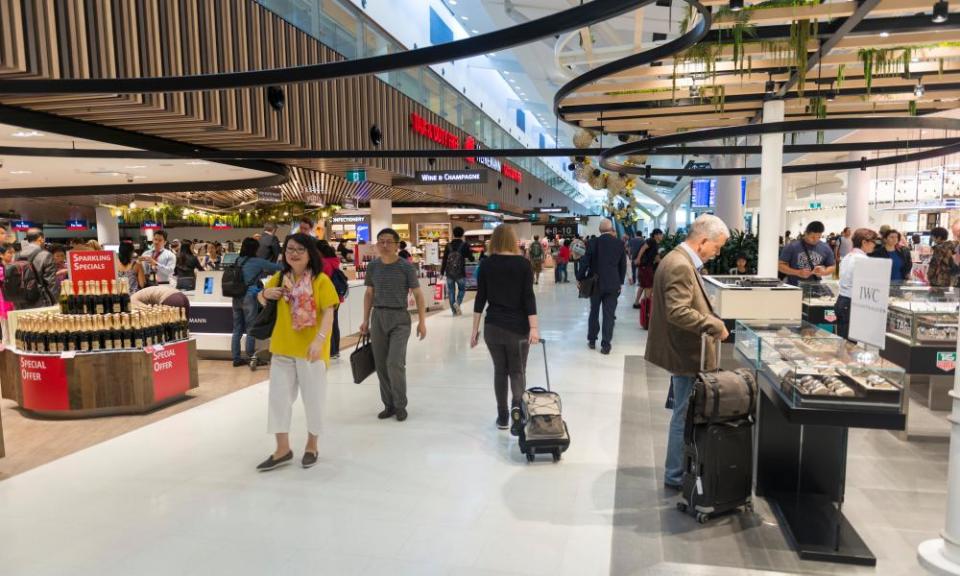'A ghost town': retail business in Australian airports in lockdown limbo

When the 11:55am Air New Zealand flight departed Sydney for Auckland on Thursday, Brenda, a pharmacist at Amcal in the international terminal, knew it would be about seven hours before her next customer entered the store.
“I’m used to it now, but in the beginning it was really weird,” the 28-year-old told the Guardian as she did stocktaking in the store throughout the afternoon, ahead of her next possible customers walking in – passengers travelling on the 8:55pm ANA flight to Tokyo.
While Brenda, and Sydneysiders living under flight paths, would hear commercial jets continuing to land at the international airport throughout the afternoon, they only carried cargo. Passengers were few and far between.
In non-pandemic times the majority of cargo would arrive in the luggage hold of passenger planes, according to a Sydney Airport spokesman. Now, boxes of cargo are taped into the seats that previously packed in passengers, to maximise the freight capacity and profit of each flight, and to help cope with a surge in online shopping orders.
Amid reports of a Canberra-Wellington air bubble, and Qantas and Jetstar’s announcement on Thursday the airlines were scaling up domestic capacity to more than 300 return flights a week by the end of June, and going up to 40% of pre-pandemic domestic flights by the end of July, the future of Australian business reliant on international air travel remained unclear.
The Amcal pharmacy, which ordinarily serves about 800 customers a day, has seen as few as 41 patrons enter the store in a day during the Covid-19 pandemic, when international border closures have been in place to all but returning citizens.

Sydney Airport recorded a drop of 98% of passengers in the month up to mid-May compared with the same period in 2019, from roughly 123,000 passengers across international and domestic terminals a day to about 3,000.
Related: Greece's quarantine-free holiday offer to Australians sounds too good to be true – and it is
Just six passenger flights left Sydney’s international terminal on Thursday, for Jakarta, San Francisco, Auckland, Tokyo, Dubai and Doha. About 20 domestic services also arrived on Thursday, with a similar number departing as a return service.
Sign up to receive the top stories from Guardian Australia every morning
With only a kebab store to compete with past the security gate, many travellers come to the Amcal not just for sanitisers and masks, but for gum and confectionery for their flights. According to Brenda, many also walk through to kill time “because there’s nothing else to do”.
“It’s a ghost town, all the high-end stores are closed out there,” Brenda, who does not wish to give her surname, says. She also notes that while the store has been reduced to skeleton staff, all have been kept on with the jobkeeper wage subsidy.
Related: Potential Virgin bidders ‘nervous’ about lack of government support
In response to the plummeting foot traffic, Sydney Airport has offered rental deferral and “rental holidays” to retail businesses, in addition to other measures including the reduction of its contractor workforce by 50%, which its chairman, Trevor Gerber, told shareholders in May allowed the airport to “guarantee” its 500 employees’ jobs until the end of September, and provide mental health services to staff.
Paul Zahra, chief executive of the Australian Retailers Association, tells the Guardian businesses based in airports have been hit by a “double edged sword”.
“Discretionary spending and air travel have been the hardest hit industries. There’s no doubt [airport retailers] have been the hardest hit ... Many have chosen not to open.”
However, Zahra says some airport shops have been forced to open pop-up stores in cities to continue business, noting Heinemann – the duty free story – is running a sale store in Sydney’s Woollahra to move expiring stock.
Zahra welcomes the news that Qantas is boosting its domestic flights, and while he says this would help regional airports especially, “from a retail view for the international terminals, it won’t have such a significant impact.”
Reductions in passenger movements have also been pronounced at regional airports, with Canberra airport shutting for a day and a half in March to save on lighting and air-conditioning costs when no flights were scheduled. While an average day for the airport pre-pandemic saw about 9,000 customers, there have been days over the past month where it opened for just 12 passengers.
Related: Court dismisses Qantas employees’ bid for paid sick leave during coronavirus crisis
However, the airport has been buoyed by news of Qantas’s increased services and the proposed Canberra-Wellington route, with Tim Dawson, the airport’s spokesman, telling the Guardian passengers numbered “into the hundreds” on Thursday.
“Domestic flight facilitates so many jobs and flow-on jobs in the economy,” Dawson says.
Announcing the increased services earlier on Thursday, Qantas chief executive Alan Joyce said services on capital city routes, particularly Melbourne-Sydney, and Canberra routes, would be increased.
“We know there is a lot of pent-up demand for air travel,” Joyce said.
However, Alison Roberts, chief executive of Airlines for Australia & New Zealand, notes that the limited domestic resumption, cargo flights and services carrying fly in, fly out workers to mines, which had continued throughout the pandemic, were not propping up airlines and airport-reliant services.
“It will be a long time until it’s back resembling anything like normal,” she said.


